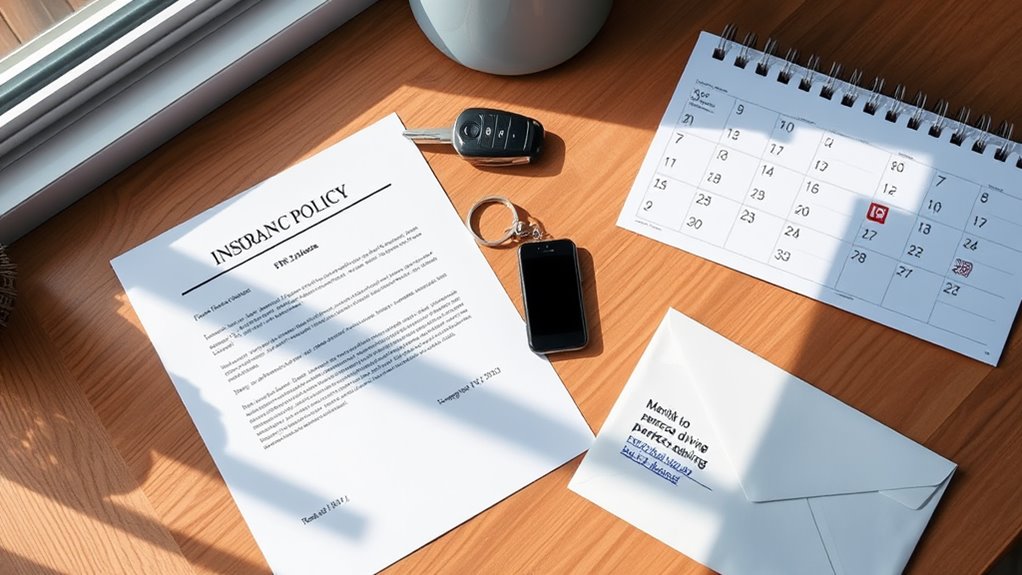Need SR-22 insurance assistance?
 CALL our licensed Agents
(Mon-Fri, 8am – 5pm PST) for personalized guidance CALL our licensed Agents
(Mon-Fri, 8am – 5pm PST) for personalized guidance
|
To remove your SR-22 requirement, you'll need to follow five essential steps. First, verify your state's mandatory filing duration, typically three years. Second, complete all court-ordered programs and pay outstanding fines. Third, maintain a spotless driving record and continuous insurance coverage throughout the requirement period. Fourth, contact your insurance provider to submit an SR-26 cancellation form once you're eligible. Finally, request formal removal through your state's DMV with proper documentation. Following these steps precisely will help guarantee a smooth shift back to standard insurance coverage, but there's more to understand about each requirement.
Check Your SR-22 Duration
Three key factors determine how long you'll need to maintain your SR-22: your state's requirements, the start date of your filing, and the specific violation that triggered the requirement.
Most states mandate SR-22 coverage for three years, though durations can range from one to ten years depending on the severity of your violation. In Texas, for example, SR22 is typically required for a minimum of two years following certain violations. Additionally, some drivers may need to consider obtaining non-owner SR22 insurance if they do not own a vehicle but still require proof of financial responsibility.
Your SR-22 period typically begins on the date of your offense, but some states may calculate it from your court date or license suspension date.
Remember that moving to a different state won't reset or change your SR-22 duration – you must complete the requirement based on your original state's rules.
For example, serious DUI offenses in Michigan require maintaining SR-22 for four years.
Contact your state's DMV to confirm your exact timeline and maintain continuous insurance coverage throughout the entire period to avoid any complications or extensions.
Meet All Legal Requirements
Maintaining an SR-22 requires strict compliance with multiple legal obligations to secure a successful completion of your filing period.
You'll need to fulfill all court-ordered requirements, including completing any mandated DUI education classes or treatment programs.
Pay off all outstanding fines and fees related to your violation, keeping detailed records of your payments. Understanding the factors influencing SR22 premiums can also help you anticipate any future costs.
It's essential to maintain continuous insurance coverage throughout the SR-22 period, as any lapse could result in license suspension.
Set up automatic payments to make sure you don't miss premium deadlines.
Submit all necessary documentation to prove your compliance, including evidence of completed programs and continuous insurance coverage.
Keep copies of all correspondence and verify proper filing with the DMV or court.
Meeting these requirements consistently will help you successfully complete your SR-22 obligation. Additionally, understanding the implications of a DWI conviction can prevent future legal issues that might extend your SR-22 requirement.
Maintain Clean Driving Record
While holding an SR-22, you'll need to demonstrate exemplary driving behavior by following all traffic laws and avoiding violations. This means strictly adhering to speed limits, traffic signals, and road signs while refraining from any reckless driving behaviors or DUI offenses.
You'll want to practice defensive driving techniques by maintaining safe following distances, staying alert to potential hazards, and anticipating other drivers' actions. Consider enrolling in a defensive driving course, which can improve your skills and may even qualify you for insurance discounts.
Don't forget to maintain continuous insurance coverage throughout your SR-22 period. Set up automatic payments or reminders to avoid any lapses, and keep detailed records of your insurance policies and payments.
Any coverage gaps could restart your SR-22 requirement.
Contact Your Insurance Provider
Once you've maintained consistent compliance with your SR-22 requirements, it's essential to contact your insurance provider about removing the filing.
Notify them that you believe you're eligible for removal and provide documentation showing your compliance history.
Your insurance provider will need to submit an SR-26 cancellation form to the state on your behalf. They'll verify your compliance record and confirm the end date of your filing period.
Make sure you've met all legal and financial obligations before requesting removal.
Keep copies of all communications and follow up proactively to confirm the filing status.
Once approved, get written confirmation of the SR-22 removal and verify that it's reflected in both your insurance policy and state records.
Consider comparing insurance quotes, as removing the SR-22 may affect your premiums.
Submit DMV Removal Request
The DMV removal request represents a critical step in eliminating your SR-22 requirement.
You'll need to contact your state's DMV office to initiate the formal removal process and confirm that your filing period has concluded.
When submitting your request, you'll need to provide extensive documentation proving your compliance with all SR-22 requirements.
This includes evidence of continuous insurance coverage, completion certificates from mandated programs, and proof that you've fulfilled all court-ordered obligations.
Be prepared to follow your state's specific protocols, which may require court approval.
Make sure to request written confirmation of the SR-22 removal from the DMV.
This documentation will serve as official proof that you're no longer subject to the requirement and should be kept for your records.
Conclusion
While SR-22 requirements can feel like a burden, you've now got the roadmap to freedom. By following these steps meticulously – from monitoring your filing period to maintaining spotless driving habits – you'll shift from restricted to regular status. Don't rush the process; instead, focus on demonstrating responsible behavior. Your patience and compliance today will lead to unrestricted driving privileges tomorrow.





